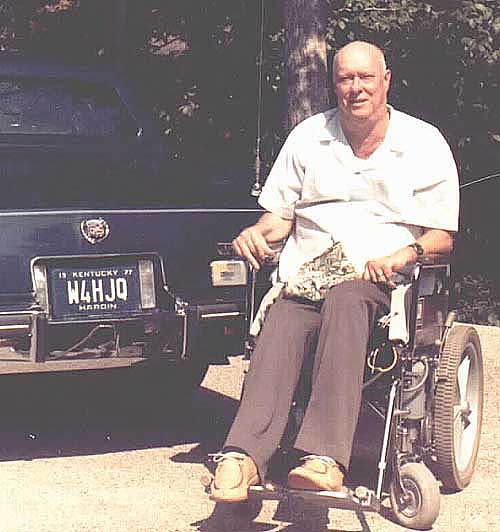
The late Tom Moody, W4HJQ.
[Photo by Melitta Moody, KC4IGW]
Click on it for larger picture.
-------------------------------------------------
by Shelby Ennis, W8WN

The late Tom Moody, W4HJQ. |
The widow of a long-time friend just called (December 1998). And this reminded me that it was nine years ago in October that Tom Moody, W4HJQ, passed away. If you have been on VHF very long, you probably worked him--most likely on 144 MHz. So, on this ninth anniversary of the passing of W4HJQ, I thought I'd remind any remaining Old Timers about the fellow they no doubt worked, probably many times, and retell his tale for the benefit of those who have come along in the years since.
Most hams--even those within the VHF/UHF community--probably did not know much about Tom. Only those of us who lived near him, plus a few special friends, knew how he operated. Tom was a quadriplegic. He also was a long-time, long-haul VHF DX operator. And Tom operated lying prone in bed.
When he was 17 years of age and in the Army, he suffered a broken neck that left him paralyzed. He had use of only his shoulder and upper arm muscles. Yet he held WAS and WAC on 28, 50, and 144 MHz. (I'm not sure what he had on 432, and I don't think he kept count on the HF bands).
Tom operated aurora (CW, of course), meteor scatter (MS) long before either SSB, keyboards or memory keyers were available, and later EME. He could have been waived on the "mechanical" part of the code exams, but he insisted on sending (while lying in bed, using a straight key) and copying on paper (requiring both hands to handle a pencil, since his fingers, hands, and wrists were not usable). He passed both the 5 and 13 WPM tests this way, and held an Advanced class license at the time of his death--which came in 1989, approximately 45 years after the accident that disabled him.
Tom was on MS almost as early as I was, starting in about 1957. He transmitted with a straight key (rotated 180 degrees so that it was more stable)! Later, he acquired an old-style keyer. Later still, he had one of the first HAL keyboards. Its hard-wired memory consisted of a network of wires strung through toroids. He still had to manually type in every letter, for the only thing stored was his own call (hard-wired in). But the keyboard was primarily for EME, for by this time SSB was coming into use for MS operation.
Tom had an uncanny ability to seemingly predict auroras. I still don't see the correlation of his method, but he knew when to be on. His excellent location and large antennas made him one of the most-heard stations in the East by any mode of propagation.
Tom died in 1989 at age 63. He did most of his operating from his father's farm outside of White Mills, Kentucky, and later lived for awhile near Radcliff, Kentucky. His widow, Melitta, KC4IGW, still lives at Radciff. We had known him since the mid-'50s, when he first became interested in Amateur Radio, and had spent many hours with him on the farm.
Sometimes we hear gripes about having to be able to copy the code. Or we complain about having to actually study and learn some theory. Or we hear of people who give up on VHF when they discover that working DX on those frequencies is a bit more difficult than working someone through the local repeater. Having known and worked with Tom for nearly 40 years, and having witnessed his patience, skills, and accomplishments, his life sure makes my life look simple!
A version of this narrative originally was posted on several VHF Reflectors last November. It also appeared on the 1999 January 15 ARRL Web Extra (for ARRL members only). An "SK" also appeared in Worldradio not long after his death.
Shelby Ennis, W8WN (ex-W4WNH), lives in Elizabethtown, Kentucky. He's a veteran VHF MS and EME operator and also was very active in ARES work in Michigan during the 1970s and 1980s.
|
Copyright© W8WN, 1999
|
